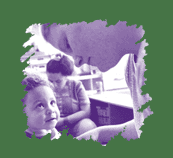



| > | Directories | |
| > | Grantee Profiles | |
| > | National Demonstration | |
| > | National Evaluation | |
| > | Program Partners | |
| > | Publications | |






Mailman School
of Public Health
Columbia University
722 West 168th Street,
8th Floor
New York, NY 10032

|
|
 |
|
Audubon Area Community Services http://www.mathematica-mpr.com/publications/PDFs/ftgkyprofile.pdf Audubon Area Community Services This model, developed in Owensboro, Kentucky, integrates multiple components. A revised family service structure is designed to allow staff to assess a family's level of need so that intensive case management services can be provided to the agency's highest risk families. Stronger families join other community residents for leadership development training that builds critical skill areas to support prevention-focused community action groups, that work in collaboration with community leaders to create strategies to address key risk and protective factors within the community. Core Strategies Taking A New Approach to Family Services
Gearing the Level of Service to Family's Needs and Strengths Introducing Intensive Case Management Those families who are assessed to be "at highest risk" are targeted for participation in intensive case management activities. The presence of multiple risk factors in the home – such as family alcohol and drug behavior and attitudes, poor and inconsistent family management practices, family conflict and/or low bonding to the family – constitutes high risk. Family Advocates receive special training and support to help them most effectively serve high-risk families. Partnering and collaborating agencies also work with Advocates to create an integrated approach to best meet the families' needs. Preparing Local Residents to Take the Lead Each year, high functioning families (both Head Start families and other families and residents from the community) are identified to participate in community development activities. The project seeks families that have strong support networks, good problem-solving skills and a passion for improving their communities and involve them in an intensive leadership training program that focuses on community development. In so doing, the model seeks to build an increasing pool of local leadership capable of carrying out primary prevention-focused community action. The leadership training prepares community residents to identify, prioritize, plan, and implement actions designed to reduce risk factors and increase protective factors for substance abuse in their families, schools, and communities. It also creates a network linking Head Start parents, other community residents and community stakeholders, allowing Head Start families the chance to engage in advocacy efforts beyond the wall of their programs to support healthy child development. Forming Community Action Groups These trained Head Start families, working in collaboration with other neighborhood residents, as well as key institutions and organizations, form a Community Action Group. Meeting bi-weekly in each target area, the community action group seeks to engage an ever-widening circle of community residents in implementing a resident-driven agenda of community building activities. Group members reach out to build relationships with their neighbors, soliciting input and perspective on the neighborhood's most critical issues. Community-based assessment activities are used to identify priority areas for action. Expanding Relationships between Residents and Community Leaders The Community Action Groups work in collaboration with an Interagency Advisory Group comprised of agency and municipal leaders to build linkages to the community power structure in order to support their primary prevention agenda. This partnership between residents and community stakeholders provides an environment that supports resident engagement in the decision-making process. It also provides an opportunity for stakeholders to hear the community's perspective, and utilize their status and power within the community to advocate for systemic changes that advance the project's prevention agenda. Taking Action As priority prevention issues are defined, community action groups develop strategic plans to bring about the desired changes at the community level. These efforts often start small, identifying workable projects that can be accomplished in a relatively short time frame. These projects might include cleaning up local vacant lots, launching a drug and alcohol awareness campaign in collaboration with a local school or organizing an alcohol-free high school event. As residents build skills and strengthen relationships with key stakeholders, collaboratively they begin to take on more complicated prevention activities – targeting environmental priorities such as improving local policing practices, reducing youth access to alcohol, improving enforcement of drug-free school zones, or seeking stronger sentences for repeat drug dealing offenses. Each community action campaign is designed not only to improve the overall environment of the community, but also to enhance residents' advocacy skills and capacity to understand how policies and practices within their local communities can be better structured to support a primary prevention agenda. |
|
Disclaimer Free To Grow is a national program supported by the Robert Wood Johnson Foundation and the Doris Duke Charitable Foundation with direction and technical assistance provided by the Mailman School of Public Health of Columbia University. |